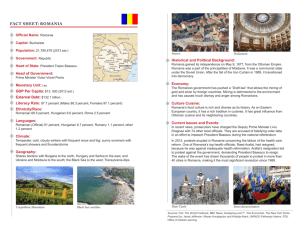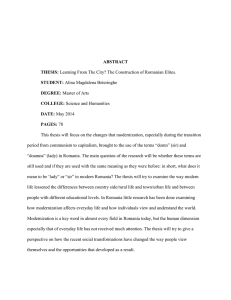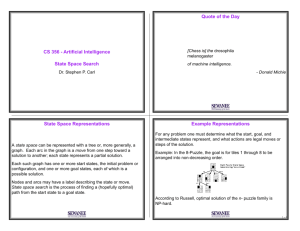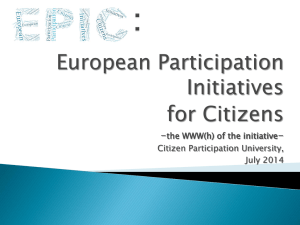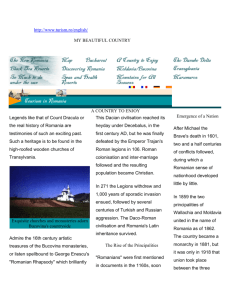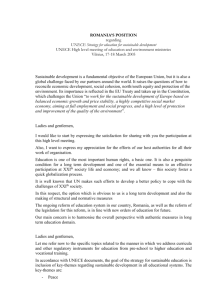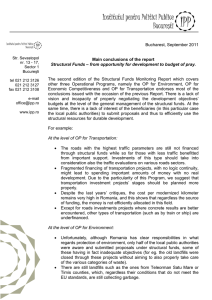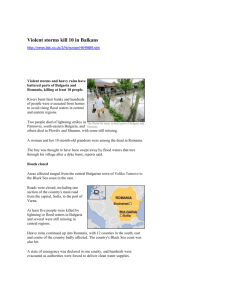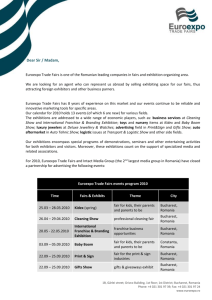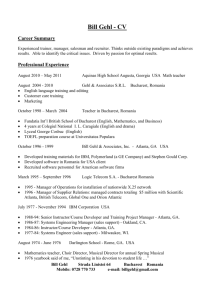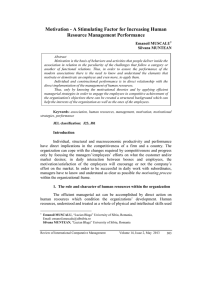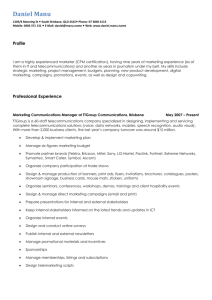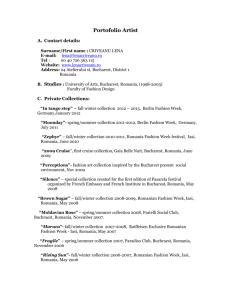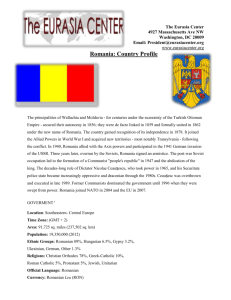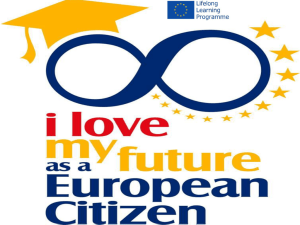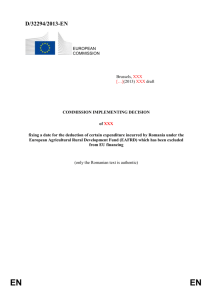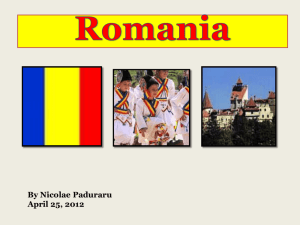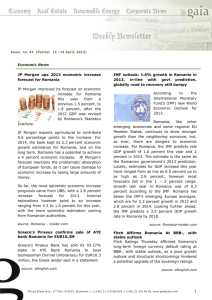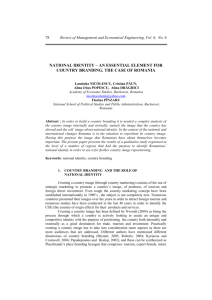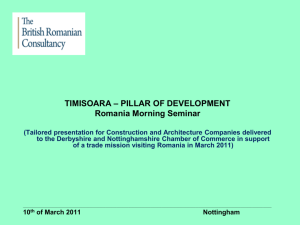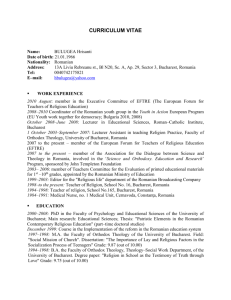Romania – background information
advertisement
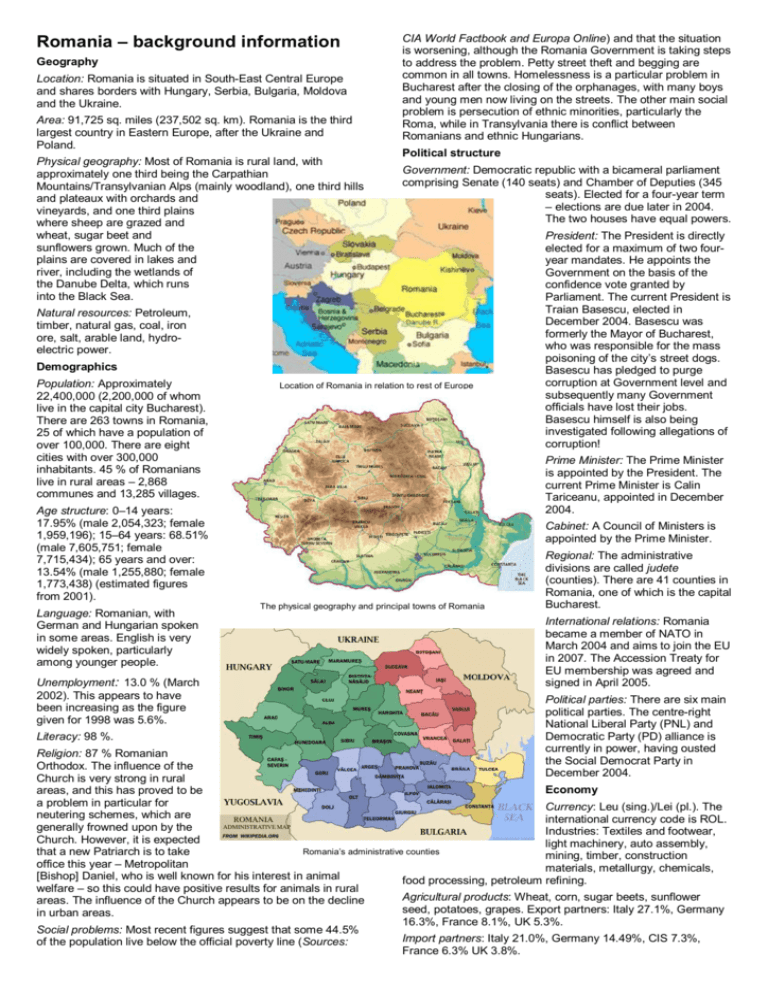
Romania – background information Geography Location: Romania is situated in South-East Central Europe and shares borders with Hungary, Serbia, Bulgaria, Moldova and the Ukraine. Area: 91,725 sq. miles (237,502 sq. km). Romania is the third largest country in Eastern Europe, after the Ukraine and Poland. Physical geography: Most of Romania is rural land, with approximately one third being the Carpathian Mountains/Transylvanian Alps (mainly woodland), one third hills and plateaux with orchards and vineyards, and one third plains where sheep are grazed and wheat, sugar beet and sunflowers grown. Much of the plains are covered in lakes and river, including the wetlands of the Danube Delta, which runs into the Black Sea. CIA World Factbook and Europa Online) and that the situation is worsening, although the Romania Government is taking steps to address the problem. Petty street theft and begging are common in all towns. Homelessness is a particular problem in Bucharest after the closing of the orphanages, with many boys and young men now living on the streets. The other main social problem is persecution of ethnic minorities, particularly the Roma, while in Transylvania there is conflict between Romanians and ethnic Hungarians. Political structure Government: Democratic republic with a bicameral parliament comprising Senate (140 seats) and Chamber of Deputies (345 seats). Elected for a four-year term – elections are due later in 2004. The two houses have equal powers. Natural resources: Petroleum, timber, natural gas, coal, iron ore, salt, arable land, hydroelectric power. Demographics Population: Approximately 22,400,000 (2,200,000 of whom live in the capital city Bucharest). There are 263 towns in Romania, 25 of which have a population of over 100,000. There are eight cities with over 300,000 inhabitants. 45 % of Romanians live in rural areas – 2,868 communes and 13,285 villages. Age structure: 0–14 years: 17.95% (male 2,054,323; female 1,959,196); 15–64 years: 68.51% (male 7,605,751; female 7,715,434); 65 years and over: 13.54% (male 1,255,880; female 1,773,438) (estimated figures from 2001). Language: Romanian, with German and Hungarian spoken in some areas. English is very widely spoken, particularly among younger people. Unemployment: 13.0 % (March 2002). This appears to have been increasing as the figure given for 1998 was 5.6%. Literacy: 98 %. Location of Romania in relation to rest of Europe President: The President is directly elected for a maximum of two fouryear mandates. He appoints the Government on the basis of the confidence vote granted by Parliament. The current President is Traian Basescu, elected in December 2004. Basescu was formerly the Mayor of Bucharest, who was responsible for the mass poisoning of the city’s street dogs. Basescu has pledged to purge corruption at Government level and subsequently many Government officials have lost their jobs. Basescu himself is also being investigated following allegations of corruption! Prime Minister: The Prime Minister is appointed by the President. The current Prime Minister is Calin Tariceanu, appointed in December 2004. Cabinet: A Council of Ministers is appointed by the Prime Minister. The physical geography and principal towns of Romania Regional: The administrative divisions are called judete (counties). There are 41 counties in Romania, one of which is the capital Bucharest. International relations: Romania became a member of NATO in March 2004 and aims to join the EU in 2007. The Accession Treaty for EU membership was agreed and signed in April 2005. Political parties: There are six main political parties. The centre-right National Liberal Party (PNL) and Democratic Party (PD) alliance is currently in power, having ousted the Social Democrat Party in December 2004. Religion: 87 % Romanian Orthodox. The influence of the Church is very strong in rural Economy areas, and this has proved to be a problem in particular for Currency: Leu (sing.)/Lei (pl.). The neutering schemes, which are international currency code is ROL. generally frowned upon by the Industries: Textiles and footwear, Church. However, it is expected light machinery, auto assembly, Romania’s administrative counties that a new Patriarch is to take mining, timber, construction office this year – Metropolitan materials, metallurgy, chemicals, [Bishop] Daniel, who is well known for his interest in animal food processing, petroleum refining. welfare – so this could have positive results for animals in rural Agricultural products: Wheat, corn, sugar beets, sunflower areas. The influence of the Church appears to be on the decline seed, potatoes, grapes. Export partners: Italy 27.1%, Germany in urban areas. 16.3%, France 8.1%, UK 5.3%. Social problems: Most recent figures suggest that some 44.5% Import partners: Italy 21.0%, Germany 14.49%, CIS 7.3%, of the population live below the official poverty line (Sources: France 6.3% UK 3.8%.
